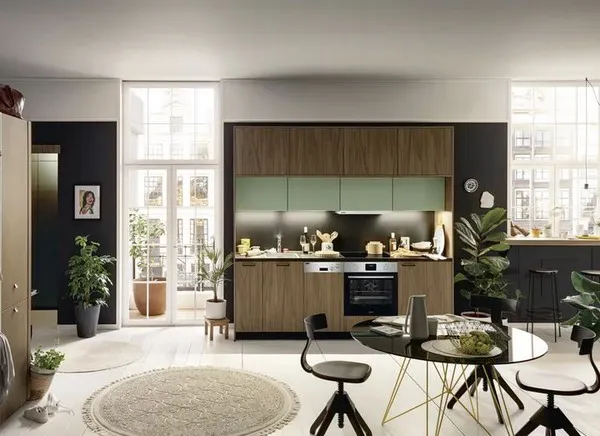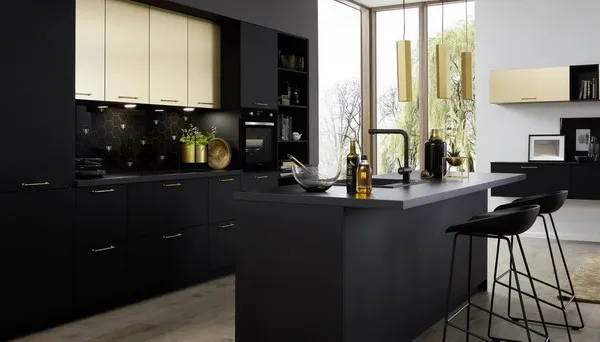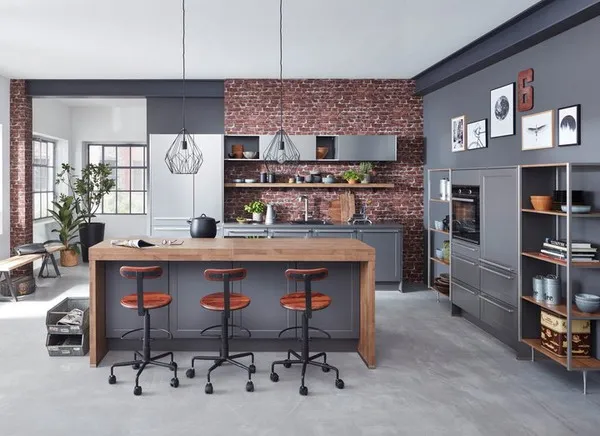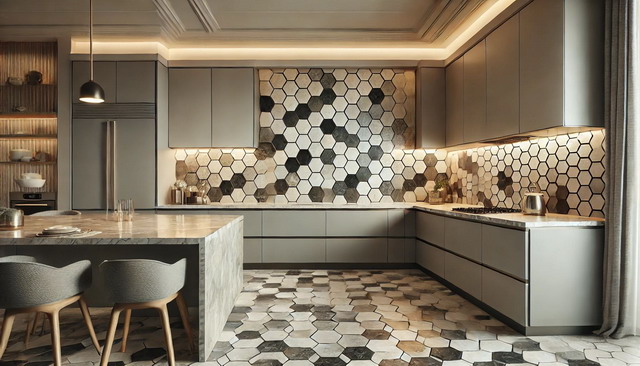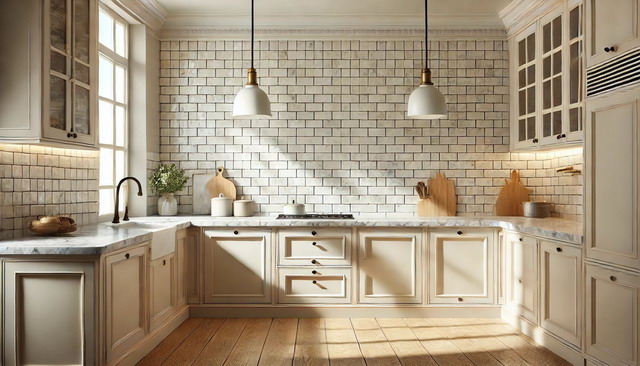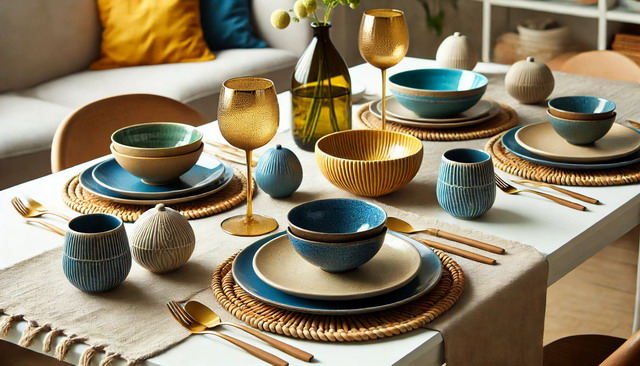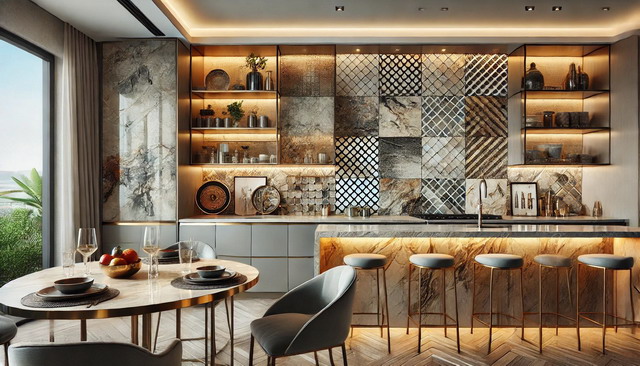Kitchen Design Trends 2025: Elevate Your Space with the Latest Styles
Last Updated on September 14, 2024 by Mutiara
The kitchen has long been considered the heart of the home—a place where meals are prepared, stories are shared, and memories are made. Over the decades, kitchen design has evolved dramatically, reflecting changes in technology, lifestyle, and aesthetic preferences. From the closed-off kitchens of the early 20th century to the open-concept layouts popularized in recent years, each era has left its mark on how we cook, dine, and socialize.
As we approach 2025, the pace of innovation in kitchen design shows no signs of slowing down. Homeowners and designers alike are seeking spaces that are not only visually stunning but also functional, efficient, and environmentally responsible. Staying updated with the latest trends isn’t just about keeping up with the Joneses; it’s about creating a kitchen that enhances your daily life and aligns with your values.
In this article, we’ll delve into the most exciting kitchen design trends anticipated for 2025. From sustainable materials to smart technology, these trends reflect a growing desire for kitchens that are both cutting-edge and kind to the planet.
Sustainable Kitchen Design Trends 2025
Sustainability is no longer a niche concern—it’s a driving force in home design. In 2025, eco-friendly kitchens are expected to take center stage, incorporating materials and technologies that reduce environmental impact without sacrificing style or convenience.
- Use of Eco-Friendly Materials
One of the most significant shifts in kitchen design is the move toward sustainable materials. Homeowners are increasingly opting for resources that are renewable, recyclable, or have a low carbon footprint.
- Bamboo and Recycled Wood: Bamboo is gaining popularity as a versatile and sustainable option for cabinetry and flooring. Its rapid growth rate makes it an eco-friendly alternative to traditional hardwoods. Similarly, recycled wood provides a rustic charm while reducing the demand for new timber.
- Recycled Metal and Glass: Countertops and backsplashes made from recycled metal or glass not only look sleek but also repurpose materials that might otherwise end up in landfills. These surfaces are durable and add a unique aesthetic to the kitchen.
- Low-VOC Finishes: Volatile Organic Compounds (VOCs) found in some paints and finishes can harm indoor air quality. Low-VOC or VOC-free products are becoming standard, promoting a healthier home environment.
- Energy-Efficient Appliances
Modern appliances are at the forefront of sustainable kitchen design. Energy efficiency is a key consideration, with manufacturers producing appliances that deliver high performance while consuming less power.
- Smart Refrigerators: These appliances optimize energy use by adjusting cooling based on the contents and frequency of door openings. Some models even provide alerts when the door is left open or when maintenance is needed.
- Induction Cooktops: Induction cooking is more energy-efficient than traditional gas or electric stovetops. It heats cookware directly through electromagnetic fields, reducing heat loss and cooking times.
- Efficient Dishwashers and Ovens: Newer models come with eco-modes that use less water and energy without compromising on cleaning or cooking performance.
- Waste Reduction Features
Minimizing waste is a crucial aspect of sustainability. Kitchens in 2025 are expected to incorporate features that make it easier to reduce, reuse, and recycle.
- Integrated Composting Units: Built-in compost bins simplify the process of collecting organic waste, encouraging homeowners to compost scraps rather than discard them.
- Waste Segregation Systems: Drawer systems with multiple bins allow for easy separation of recyclables, reducing the contamination of recyclable materials.
- Smart Inventory Management: Some kitchens now include technology that tracks pantry items, helping to reduce food waste by alerting users when items are nearing expiration.
By embracing these sustainable design trends, homeowners can create kitchens that are not only beautiful and functional but also contribute positively to the environment. The shift toward eco-friendly materials, energy-efficient appliances, and waste reduction features reflects a broader commitment to sustainability that is poised to define kitchen design in 2025 and beyond.
Smart Kitchen Technology 2025
In the realm of kitchen design, technology is playing an increasingly pivotal role. By 2025, smart kitchens are set to become more intuitive and interconnected than ever before, transforming the way we interact with our culinary spaces.
- Integration of AI and IoT in Kitchens
Artificial Intelligence (AI) and the Internet of Things (IoT) are revolutionizing kitchen functionality. The integration of these technologies allows appliances and devices to communicate seamlessly, creating a cohesive and efficient environment.
- Predictive Cooking Appliances: Ovens and cooktops equipped with AI can learn your cooking habits, suggesting recipes based on available ingredients or dietary preferences. They can adjust cooking times and temperatures automatically to ensure perfect results every time.
- Inventory Management Systems: Smart refrigerators now come with internal cameras and barcode scanners that track the contents of your fridge. They can notify you when items are running low or about to expire, and even add them to your shopping list or online cart.
- Energy Management: IoT-enabled devices monitor energy consumption, optimizing appliance performance to reduce utility bills and environmental impact. They can schedule operations during off-peak hours or when renewable energy sources are most available.
- Voice-Controlled Devices
Voice assistants have become household staples, and their integration into the kitchen is enhancing convenience and safety.
- Hands-Free Operation: With voice commands, you can adjust oven temperatures, set timers, or control lighting without touching a single button. This is especially useful when your hands are full or messy during meal preparation.
- Recipe Guidance: Voice assistants can guide you through recipes step-by-step, pausing and resuming as needed. They can convert measurements, suggest substitutions, and even adjust recipes based on serving sizes.
- Safety Features: Voice control minimizes the need to handle appliances manually, reducing the risk of cross-contamination or accidents. You can check if the stove is on or turn off appliances remotely, providing peace of mind.
- Smart Appliances and Their Benefits
The latest generation of smart appliances is designed to anticipate your needs, making kitchen tasks more efficient and enjoyable.
- Connected Refrigerators: Beyond inventory tracking, these fridges can recommend meals based on what’s inside and your dietary goals. Some models feature touchscreens that serve as family hubs for calendars, notes, and entertainment.
- Intelligent Ovens: Smart ovens can download cooking instructions directly from recipes, adjust settings mid-cook, and notify you via smartphone when your dish is ready. Some even have built-in cameras so you can monitor your food without opening the door.
- Adaptive Dishwashers: These appliances adjust water pressure, temperature, and cycle length based on the load’s dirtiness, ensuring optimal cleaning while conserving resources.
The smart kitchen of 2025 is all about creating a responsive environment that simplifies cooking, enhances safety, and adds a layer of personalization to your culinary experience. By embracing AI and IoT technologies, homeowners can enjoy a kitchen that not only meets but anticipates their needs.
Minimalist Kitchen Ideas for 2025
Minimalism continues to influence kitchen design, with 2025 bringing fresh interpretations that focus on simplicity, functionality, and beauty.
- Embracing Simplicity
The minimalist kitchen is characterized by clean lines, uncluttered surfaces, and a restrained color palette.
- Streamlined Aesthetics: Cabinetry without handles, integrated appliances, and seamless surfaces create a cohesive look. The emphasis is on form and function, eliminating unnecessary ornamentation.
- Monochromatic Schemes: Utilizing shades of a single color enhances the sense of space and serenity. Whites, grays, and earthy tones are popular choices, providing a neutral backdrop that highlights architectural features.
- Quality Over Quantity: Minimalism encourages investing in high-quality materials and finishes that stand the test of time, both in durability and style.
- Hidden Storage Solutions
Innovative storage is key to maintaining the minimalist ethos by keeping clutter out of sight.
- Concealed Cabinets: Floor-to-ceiling cabinetry with push-to-open doors hides kitchen essentials while maximizing storage space. Appliance garages keep small devices like toasters and mixers accessible yet out of view.
- Pull-Out Systems: Deep drawers with customizable dividers and pull-out shelves make it easy to organize utensils, pots, and pantry items efficiently.
- Under-Cabinet Solutions: Utilizing the space beneath upper cabinets for lighting, knife strips, or spice racks keeps countertops clear and items within reach.
- Functional Minimalism
The minimalist kitchen isn’t just about aesthetics; it’s about creating a space that enhances usability.
- Ergonomic Design: Thoughtful placement of workstations—prep areas, cooking zones, and cleaning stations—optimizes workflow and reduces unnecessary movement.
- Multipurpose Features: Kitchen islands double as dining tables or workspaces, and surfaces serve multiple functions, adapting to the user’s needs.
- Sustainable Choices: Minimalism aligns with sustainability by promoting the use of durable, eco-friendly materials and reducing excess consumption.
Minimalist kitchen design in 2025 is about more than just a look; it’s a lifestyle choice that promotes simplicity, efficiency, and mindfulness. By focusing on what truly matters, homeowners can create a kitchen that is both aesthetically pleasing and perfectly tailored to their needs.
Kitchen Color Trends in 2025
Color plays a vital role in setting the mood and style of a kitchen. In 2025, we’re seeing a dynamic mix of hues that bring personality and warmth to the heart of the home.
- Popular Color Palettes
The upcoming year embraces both bold and subtle color schemes, reflecting individual tastes and design trends.
- Earthy Neutrals: Colors inspired by nature—such as soft greens, warm beiges, and muted browns—create a calming and welcoming environment. These tones pair well with natural materials like wood and stone.
- Deep Blues and Greens: Rich shades like navy blue and forest green add depth and sophistication. Used on cabinetry or as accent walls, these colors make a strong statement without overwhelming the space.
- Pastel Shades: Light pinks, blues, and yellows bring a fresh and airy feel to the kitchen. They work well in minimalist designs, adding a touch of color without disrupting the harmony.
- Use of Bold Accents
Adding pops of color is a popular way to inject energy and personality into the kitchen.
- Colorful Backsplashes: Vibrant tiles in geometric patterns or artistic designs become focal points, adding visual interest and character.
- Statement Appliances: Retro-inspired appliances in bright reds, yellows, or blues serve as functional art pieces that enliven the space.
- Accessories and Decor: Bar stools, pendant lights, and dishware in bold hues can be easily updated, allowing for flexibility as trends change.
- Neutral Tones and Their Appeal
Neutral colors remain a staple in kitchen design due to their timeless appeal and versatility.
- White and Off-White: These shades reflect light, making spaces appear larger and more open. They provide a clean canvas that complements any style or accent color.
- Gray Undertones: Grays with warm or cool undertones offer sophistication and modernity. They work well with stainless steel appliances and contemporary designs.
- Black Accents: Used sparingly, black adds contrast and drama. Matte black fixtures and hardware are trending, providing a sleek and modern touch.
The color trends of 2025 encourage homeowners to express themselves, whether through bold choices or subtle nuances. By carefully selecting colors that resonate with personal style and complement the overall design, the kitchen becomes a true reflection of individuality and taste.
Open-Concept Kitchen Designs 2025
The way we use our homes is continually evolving, and nowhere is this more evident than in the kitchen. In 2025, open-concept kitchen designs are reaching new heights, emphasizing seamless integration with living spaces and prioritizing flow and functionality like never before.
- Seamless Integration with Living Spaces
Modern lifestyles blur the lines between cooking, dining, and entertaining. The open-concept kitchen of 2025 is designed to be the heart of the home, fostering connection and facilitating multitasking.
- Unified Aesthetics: Consistency is key. Using the same flooring materials, color schemes, and design elements throughout the kitchen and adjoining living areas creates a harmonious flow. For example, extending hardwood floors from the living room into the kitchen or using complementary cabinetry and furniture styles ties the spaces together.
- Multi-Functional Furniture: Kitchen islands double as dining tables or workstations, equipped with comfortable seating and ample surface area. These islands become social hubs where cooking and conversation coexist.
- Invisible Boundaries: Strategic lighting, area rugs, or ceiling treatments subtly define different zones without erecting physical barriers. This approach maintains the openness while giving each area a distinct purpose.
- Benefits of Open-Concept Layouts
The open-concept kitchen isn’t just a design trend; it’s a reflection of how we live.
- Enhanced Social Interaction: Hosts can engage with guests or keep an eye on children while preparing meals. The kitchen becomes a communal space rather than a secluded workspace.
- Increased Natural Light: With fewer walls, natural light flows freely, creating a brighter, more inviting environment. This not only improves aesthetics but can also contribute to better mood and energy levels.
- Flexibility and Adaptability: Open spaces can be easily reconfigured to accommodate different activities, from dinner parties to family game nights. Furniture can be rearranged without the constraints of walls.
- Designing for Flow and Functionality
While openness is desirable, it’s crucial to maintain practicality.
- Efficient Work Zones: The classic kitchen work triangle (sink, stove, refrigerator) remains essential. In an open layout, ensuring these elements are positioned for convenience prevents inefficiency.
- Noise and Odor Management: Open kitchens can spread cooking noises and smells throughout the home. High-quality ventilation systems and sound-absorbing materials help mitigate these issues.
- Storage Solutions: With fewer walls for cabinets, creative storage becomes vital. Incorporating floor-to-ceiling pantry units or island storage ensures that functionality isn’t sacrificed for style.
Innovative Kitchen Storage Solutions 2025
As kitchens become more streamlined and multifunctional, innovative storage solutions are paramount. The year 2025 brings a wealth of clever ideas to maximize space and enhance organization.
- Maximizing Small Spaces
Urban living often means smaller kitchens. Designers are rising to the challenge with solutions that make the most of limited square footage.
- Vertical Storage: Utilizing wall space with tall cabinets or open shelving reaches new heights—literally. Overhead pot racks or hanging herb gardens add storage and charm.
- Corner Innovations: Lazy Susans and pull-out corner drawers transform previously wasted space into accessible storage for cookware or pantry items.
- Sliding and Folding Features: Pull-out cutting boards, fold-down tables, and sliding countertops provide extra workspace when needed and tuck away to save space.
- Customizable Cabinetry
Personalization is key. Cabinets and storage solutions adapt to individual needs.
- Adjustable Shelving: Shelves that can be moved or reconfigured accommodate items of varying sizes, from tall cereal boxes to small spice jars.
- Specialized Compartments: Drawers with built-in organizers for utensils, knives, or baking sheets keep everything in its place and easily accessible.
- Smart Technology Integration: Cabinets with sensors that light up when opened or alert you when supplies are low bring storage into the digital age.
- Pull-Out and Modular Options
Flexibility is the future of kitchen storage.
- Pull-Out Pantries: Slim cabinets that slide out reveal shelves for canned goods, spices, or snacks, making use of narrow spaces.
- Modular Units: Cabinets and islands that can be rearranged or added to over time adapt to changing needs or tastes.
- Hidden Storage: Toe-kick drawers beneath lower cabinets, secret compartments in benches or islands, and concealed appliance garages keep the kitchen clutter-free.
Eco-Friendly Kitchen Materials 2025
Sustainability is more than a buzzword—it’s a guiding principle in 2025 kitchen design. Eco-friendly materials are at the forefront, combining style with environmental responsibility.
- Sustainable Countertops and Flooring
Choosing green materials doesn’t mean compromising on aesthetics or durability.
- Recycled Glass Countertops: Made from post-consumer glass, these countertops are not only environmentally friendly but also offer a unique, colorful appearance that can be a real conversation starter.
- Bamboo and Cork Flooring: Both materials are rapidly renewable. Bamboo provides a sleek, modern look similar to hardwood, while cork offers a softer feel underfoot and natural insulation properties.
- Reclaimed Wood: Using wood salvaged from old buildings adds character and history to floors or countertops, reducing the demand for new lumber.
- Recycled and Reclaimed Resources
Incorporating recycled materials reduces waste and often brings unique textures and stories into the kitchen.
- Reclaimed Tile: Tiles made from recycled ceramics or glass can be used for backsplashes or flooring, adding intricate patterns and colors.
- Recycled Metal Fixtures: Lighting fixtures, hardware, or even sinks made from recycled metals like copper or stainless steel contribute to a sustainable kitchen design.
- Upcycled Decor: Repurposing items like antique furniture for kitchen islands or shelving adds charm and reduces the environmental footprint.
- Low VOC Paints and Finishes
Indoor air quality is an essential aspect of a healthy home.
- Zero or Low-VOC Paints: Traditional paints can release volatile organic compounds (VOCs) that affect air quality. Low-VOC alternatives are safer and just as vibrant.
- Natural Finishes: Oils and waxes derived from natural sources protect wood surfaces without harmful emissions.
- Eco-Friendly Adhesives: Glues and sealants can also be significant sources of VOCs. Opting for eco-friendly versions ensures that every layer of your kitchen is as green as possible.
By embracing these eco-friendly materials, homeowners are contributing to a healthier planet while creating beautiful, functional spaces. The kitchens of 2025 prove that sustainability and style go hand in hand, offering innovative solutions that don’t sacrifice aesthetics for responsibility.
The kitchen design trends of 2025 reflect a deepening commitment to spaces that are not only visually appealing but also aligned with the way we live now—connected, conscious, and ever-evolving. From open-concept layouts that foster togetherness to storage solutions that make life easier, and eco-friendly materials that honor our environment, these trends offer something for everyone. As you consider your kitchen’s future, these insights provide a roadmap to a space that’s both on-trend and uniquely yours.
Multi-Functional Kitchen Islands 2025
The kitchen island has evolved from a simple countertop extension to a central feature that embodies the fusion of style, functionality, and social interaction. In 2025, multi-functional kitchen islands are more versatile than ever, serving as the heartbeat of the modern kitchen.
- Islands as Social Hubs
The kitchen island has become the epicenter of household activity, transcending its traditional role.
- Entertainment Space: Islands are designed to facilitate gatherings, with ample seating and open spaces that encourage conversation. Whether hosting a casual brunch or a formal dinner party, the island serves as a natural gathering point.
- Family Interactions: For families, the island becomes a place where children do homework while parents prepare meals, fostering togetherness. It blurs the line between work and leisure, making the kitchen a truly communal space.
- Culinary Demonstrations: For the cooking enthusiast, the island provides a stage to showcase culinary skills, turning meal prep into a shared experience with guests or family members.
- Incorporating Appliances
Integrating appliances into the kitchen island maximizes efficiency and streamlines workflow.
- Built-In Cooktops and Sinks: Incorporating a cooktop or sink into the island creates a functional workstation that allows the cook to face outward, maintaining engagement with others in the room.
- Wine Coolers and Beverage Stations: Adding a wine fridge or beverage drawer transforms the island into a self-contained entertainment center, making it easy to serve drinks without interrupting the cooking process.
- Charging Stations and Smart Controls: USB ports, wireless charging pads, and integrated controls for smart appliances keep technology at your fingertips, supporting a modern lifestyle.
- Storage and Seating Solutions
Multi-functional islands offer innovative storage and comfortable seating, enhancing both utility and comfort.
- Ample Storage: Deep drawers, pull-out shelves, and custom compartments within the island keep cookware, utensils, and even pantry items organized and accessible.
- Breakfast Bars and Casual Dining: Extended countertops with overhangs provide space for bar stools or chairs, creating an informal dining area perfect for quick meals or socializing.
- Flexible Design: Some islands feature movable or expandable sections that can be adjusted based on the occasion, offering flexibility for different activities or group sizes.
Integrated Appliances in Kitchen Design 2025
The seamless integration of appliances is a hallmark of contemporary kitchen design. In 2025, this trend reaches new levels of sophistication, emphasizing aesthetics, efficiency, and harmony within the space.
- Sleek Appliance Integration
Modern kitchens favor a cohesive look where appliances blend effortlessly with cabinetry and surfaces.
- Built-In Appliances: Ovens, microwaves, and coffee makers are installed flush with cabinets, eliminating protrusions and creating clean lines.
- Uniform Finishes: Matching the finish of appliances with cabinetry—such as matte black, stainless steel, or custom paneling—enhances visual continuity.
- Minimalist Controls: Touchscreen interfaces and concealed buttons reduce visual clutter, contributing to a streamlined appearance.
- Concealed Appliances
Hiding appliances behind cabinetry or within the design itself is a growing trend.
- Panel-Ready Designs: Refrigerators and dishwashers can be fitted with panels that match the surrounding cabinetry, making them virtually disappear.
- Pop-Up and Slide-Out Features: Ventilation hoods that retract when not in use and cooktops that blend into the countertop offer functionality without dominating the visual landscape.
- Hidden Small Appliances: Appliance garages or dedicated storage keep items like toasters and blenders out of sight yet easily accessible.
- Benefits of Seamless Designs
Integrated appliances offer both aesthetic and practical advantages.
- Enhanced Space Perception: A cohesive look makes the kitchen appear larger and more open, especially important in smaller spaces.
- Ease of Cleaning: Smooth surfaces and reduced crevices simplify cleaning, promoting a hygienic environment.
- Timeless Appeal: Seamless designs transcend fleeting trends, providing a classic look that remains stylish over time.
Future of Kitchen Lighting 2025
Lighting is a critical element that shapes the functionality and ambiance of the kitchen. In 2025, advancements in technology and design offer exciting possibilities for illuminating this central space.
- Energy-Efficient Lighting Solutions
Sustainability continues to influence lighting choices, with energy efficiency at the forefront.
- LED Technology: LEDs have become the standard, offering longevity and significant energy savings compared to traditional bulbs. They are available in various color temperatures to suit different moods and tasks.
- Solar Integration: For eco-conscious homeowners, solar-powered lighting options reduce reliance on the grid and harness renewable energy.
- Smart Energy Management: Systems that adjust lighting based on time of day or occupancy optimize energy use without sacrificing convenience.
- Smart Lighting Systems
The integration of smart technology transforms kitchen lighting into a dynamic and responsive system.
- Voice and App Control: Adjust lighting levels, colors, and schedules through voice commands or smartphone apps, tailoring the environment to your needs.
- Adaptive Lighting: Systems that mimic natural light patterns support circadian rhythms, enhancing well-being by adjusting brightness and warmth throughout the day.
- Scene Setting: Pre-programmed settings for cooking, dining, or entertaining allow for instant ambiance changes at the touch of a button.
- Ambient and Task Lighting Trends
A layered lighting approach balances practicality with aesthetics.
- Under-Cabinet Lighting: LED strips beneath cabinets illuminate countertops, providing essential task lighting for food preparation.
- Pendant Lights and Chandeliers: Decorative fixtures above islands or dining areas add personality and style, serving as focal points that reflect the homeowner’s taste.
- Recessed and Cove Lighting: Subtle installations that wash walls or ceilings with light enhance the sense of space and add a sophisticated touch.
The kitchen design trends of 2025 are a testament to the ongoing evolution of the heart of the home. Multi-functional kitchen islands redefine social and practical uses of space, integrated appliances offer sleek efficiency, and innovative lighting solutions create environments that are both inviting and energy-conscious. As technology advances and design philosophies shift toward greater sustainability and personalization, the modern kitchen becomes a reflection of our lifestyles and values. Embracing these trends allows homeowners to craft spaces that are not only on the cutting edge of style and functionality but also uniquely suited to their individual needs and aspirations.
Biophilic Design in Kitchens 2025
In 2025, the biophilic design movement continues to gain momentum, bringing the tranquility and beauty of nature into our homes—especially the kitchen. This approach not only enhances aesthetic appeal but also promotes well-being by fostering a connection with the natural environment.
- Incorporating Natural Elements
Bringing natural materials and elements into the kitchen creates a serene and organic atmosphere.
- Wood and Stone Accents: Using raw or reclaimed wood for cabinetry, shelving, or beams adds warmth and texture. Stone countertops or backsplashes introduce rugged elegance and durability.
- Natural Textures and Patterns: Incorporating materials that showcase natural patterns, such as marble veining or wood grain, adds visual interest and a sense of authenticity.
- Water Features: Small indoor fountains or aquariums can introduce the calming presence of water, enhancing the sensory experience of the kitchen.
- Indoor Herb Gardens
Growing plants indoors is a key aspect of biophilic design, and the kitchen is the perfect place for it.
- Vertical Gardens: Wall-mounted planters or living walls maximize space while bringing greenery into the kitchen. They can be used to grow herbs, small vegetables, or decorative plants.
- Windowsill Planters: Utilizing windowsills for potted herbs ensures fresh ingredients are always at hand, and the greenery adds a lively touch to the space.
- Smart Gardening Systems: Automated indoor gardens with built-in lighting and irrigation make it easy to cultivate plants year-round, even in kitchens with limited natural light.
- Natural Lighting and Ventilation
Maximizing natural light and fresh air enhances the biophilic atmosphere.
- Large Windows and Skylights: Expanding window areas or adding skylights floods the kitchen with daylight, reducing the need for artificial lighting and connecting the interior with the outside world.
- Glass Doors and Partitions: Using glass elements in doors or partitions maintains an open feel and allows light to flow between spaces.
- Cross Ventilation: Designing the kitchen layout to encourage airflow improves indoor air quality and brings in refreshing outdoor scents.
Contemporary Kitchen Backsplash Ideas 2025
The backsplash has evolved into a central design feature in modern kitchens. In 2025, contemporary backsplash trends are all about creativity, functionality, and making a statement.
- Trending Materials and Patterns
Innovative materials and bold patterns are at the forefront of backsplash design.
- Textured Tiles: Three-dimensional tiles add depth and interest, creating a tactile and visually engaging surface.
- Metallic Finishes: Copper, brass, and stainless steel backsplashes introduce a sleek, industrial vibe. These materials are not only stylish but also easy to clean and maintain.
- Large Format and Continuous Surfaces: Using large slabs of marble, quartz, or glass minimizes grout lines for a seamless look and emphasizes the beauty of the material.
- Statement Backsplashes
The backsplash can serve as a focal point, expressing personal style and creativity.
- Artistic Murals and Patterns: Custom-designed tiles or hand-painted murals transform the backsplash into a piece of art. Geometric patterns or abstract designs add a modern touch.
- Bold Colors: Vibrant hues like deep blues, emerald greens, or rich terracottas can make the backsplash stand out against neutral cabinetry.
- Mixed Materials: Combining different materials, such as wood and tile or metal and glass, creates a unique and personalized look.
- Easy-to-Clean Options
Practicality is essential in the kitchen, and backsplashes should be both beautiful and functional.
- Smooth Surfaces: Materials like glass or polished stone are easy to wipe down, making cleanup after cooking a breeze.
- Protective Coatings: Sealants and specialized coatings can make porous materials more resistant to stains and moisture.
- Grout Innovations: Using stain-resistant or epoxy grouts reduces discoloration over time and keeps the backsplash looking fresh.
Trending Kitchen Countertop Materials 2025
Countertops are a vital component of kitchen design, balancing aesthetics, functionality, and durability. In 2025, new materials and approaches are redefining this essential surface.
- Durable and Sustainable Options
Eco-friendly and long-lasting materials are top choices for modern countertops.
- Quartz and Engineered Stone: Offering the beauty of natural stone with enhanced durability, quartz countertops are non-porous, scratch-resistant, and come in a variety of colors and patterns.
- Recycled Materials: Countertops made from recycled glass, paper composite, or reclaimed wood reduce environmental impact and often feature unique, eye-catching designs.
- Solid Surface Materials: Innovations in acrylic and resin-based countertops provide seamless surfaces that are easy to maintain and repair.
- Mixing and Matching Surfaces
Combining different countertop materials adds functionality and visual interest.
- Zoned Workstations: Using different materials for specific areas—like a butcher block section for chopping or a marble slab for baking—enhances usability.
- Contrasting Colors and Textures: Pairing smooth surfaces with textured ones, or light colors with dark, creates dynamic contrasts that elevate the kitchen’s design.
- Edge Details: Varying the thickness or edge profiles of countertops, such as waterfall edges or chamfered corners, adds a custom touch.
- Innovative Finishes
New finishes offer fresh looks and improved performance.
- Matte and Honed Finishes: Non-reflective surfaces are gaining popularity for their understated elegance and ability to hide smudges or fingerprints.
- Leathered and Textured Finishes: Adding texture to stone surfaces provides a unique tactile experience and can make the countertop less slippery.
- Antimicrobial Treatments: Surfaces treated with antimicrobial agents promote hygiene by inhibiting the growth of bacteria and mold.
The kitchen design landscape of 2025 is rich with innovation and creativity. Biophilic design brings the serenity of nature indoors, fostering environments that nurture both body and soul. Contemporary backsplash ideas turn functional elements into artistic statements, allowing homeowners to express their unique style. Trending countertop materials offer a blend of sustainability, durability, and aesthetic appeal, meeting the demands of modern life.
By embracing these trends, homeowners can create kitchens that are not only visually stunning but also aligned with their values and lifestyles. Whether through the calming influence of natural elements, the bold expression of a statement backsplash, or the practical elegance of cutting-edge countertop materials, the kitchens of 2025 are spaces where beauty, functionality, and personal expression converge.
As we continue to seek environments that inspire and support us, these design trends provide a pathway to kitchens that are truly the heart of the home—places where memories are made, meals are shared, and life unfolds.
Kitchen Flooring Trends 2025
The kitchen floor is more than just a surface to stand on; it’s a foundational element that ties the entire room together. In 2025, kitchen flooring trends are emphasizing both aesthetics and functionality, offering materials that are beautiful, durable, and sustainable.
- Popular Flooring Materials
Choosing the right flooring sets the tone for the kitchen’s overall design.
- Sustainable Hardwood: Hardwood floors remain a timeless choice, but there’s a growing emphasis on sustainably sourced wood. Options like reclaimed timber or certified sustainable products provide the classic warmth of wood while being environmentally responsible.
- Porcelain and Ceramic Tiles: Advances in printing technology allow these tiles to mimic natural materials like wood and stone convincingly. They’re durable, water-resistant, and available in a wide range of styles and sizes, making them a versatile option for any kitchen design.
- Luxury Vinyl Planks (LVP): LVP offers the look of wood or stone with added durability and comfort underfoot. It’s also water-resistant and easier to install and maintain, making it an increasingly popular choice.
- Heated Floors
Comfort is becoming a priority in kitchen design, and heated floors are a luxurious yet practical trend.
- Radiant Floor Heating: Installing radiant heating beneath tile, stone, or even engineered wood floors provides consistent warmth. It’s energy-efficient and eliminates the need for additional heating sources in the kitchen.
- Enhanced Comfort: Heated floors make the kitchen more inviting, especially in colder climates or during winter months. They contribute to a cozy atmosphere that’s perfect for family gatherings and entertaining.
- Health Benefits: Radiant heating reduces the circulation of dust and allergens compared to forced-air systems, promoting better indoor air quality.
- Durable and Low-Maintenance Choices
Today’s homeowners seek flooring options that stand up to the demands of a busy kitchen.
- Concrete Flooring: Polished concrete is gaining traction for its industrial chic aesthetic and unparalleled durability. It’s resistant to scratches, stains, and moisture, making it ideal for high-traffic areas.
- Cork Flooring: Cork is a renewable resource that’s soft underfoot and naturally antimicrobial. It’s also an excellent insulator, helping to regulate temperature and reduce noise.
- Engineered Stone: Materials like quartz composite offer the beauty of natural stone with enhanced durability and lower maintenance. They’re resistant to stains and scratches, making them suitable for active kitchens.
Personalized Kitchen Spaces 2025
In 2025, personalization is key to kitchen design. Homeowners are moving away from cookie-cutter layouts, opting instead for spaces that reflect their unique lifestyles, preferences, and needs.
- Custom Designs to Fit Lifestyles
Tailoring the kitchen to individual habits enhances both functionality and enjoyment.
- Ergonomic Workflows: Designing the kitchen layout around how you cook—from prep to plating—optimizes efficiency. This might involve customized counter heights, strategically placed appliances, or dedicated zones for specific tasks like baking or coffee brewing.
- Specialized Storage: Custom cabinetry can be designed to accommodate unique collections, such as wine racks for enthusiasts or pull-out shelves for heavy appliances, reducing clutter and improving accessibility.
- Lifestyle Integration: For those who entertain frequently, integrating features like a wet bar, wine cooler, or larger dining spaces makes hosting seamless. Families might prioritize a homework nook or play area within sight of the kitchen.
- Personal Touches and Décor
Incorporating personal elements transforms the kitchen into a true reflection of its owner.
- Colorful Accents: Whether through bold cabinetry, vibrant backsplashes, or colorful appliances, introducing favorite hues adds personality and joy to the space.
- Artwork and Decor: Displaying art, photographs, or cherished items on open shelving or walls infuses the kitchen with character and tells a story.
- Unique Materials: Selecting distinctive materials like custom tiles, reclaimed wood, or handcrafted hardware makes the kitchen one-of-a-kind.
- Flexible and Adaptable Layouts
Life is dynamic, and kitchens designed for flexibility can adapt to changing needs.
- Modular Furniture: Movable islands, adjustable shelving, and reconfigurable seating allow the kitchen to evolve over time, accommodating new appliances or shifting family dynamics.
- Technology Integration: Designing with future tech upgrades in mind—such as additional outlets, charging stations, or smart home compatibility—ensures the kitchen remains current.
- Multifunctional Spaces: Creating areas that serve multiple purposes, like a countertop that doubles as a dining table or a desk, maximizes space and utility.
Conclusion
- Recap of Key Trends
The kitchen design trends of 2025 showcase a blend of innovation, sustainability, and personalization. From eco-friendly flooring options and heated comfort to bespoke layouts and personal touches, these trends reflect a shift towards kitchens that are not just functional but also deeply personal and reflective of individual lifestyles.
- Importance of Personal Preference
While trends offer inspiration, the heart of kitchen design lies in personal preference. Your kitchen should cater to your habits, tastes, and needs. Whether you prioritize cutting-edge technology, sustainable materials, or a cozy, traditional atmosphere, it’s essential to create a space that feels authentic and comfortable to you.
- Embracing Innovation in Kitchen Design
Embracing innovation doesn’t mean discarding the classics; it’s about integrating new ideas in ways that enhance daily living. The advancements in materials, technology, and design principles provide opportunities to create kitchens that are more efficient, enjoyable, and tailored to individual needs than ever before.
Final Thoughts
As we move into 2025, the kitchen remains the dynamic center of the home—a place where innovation meets tradition, and personal expression flourishes. By considering these trends and reflecting on your unique preferences, you can design a kitchen that not only meets your practical needs but also becomes a cherished space for making memories.
Whether you’re embarking on a complete renovation or simply looking to update certain elements, let these insights guide you in creating a kitchen that is truly the heart of your home. Embrace the possibilities, and craft a space where form, function, and personal style come together in perfect harmony.
